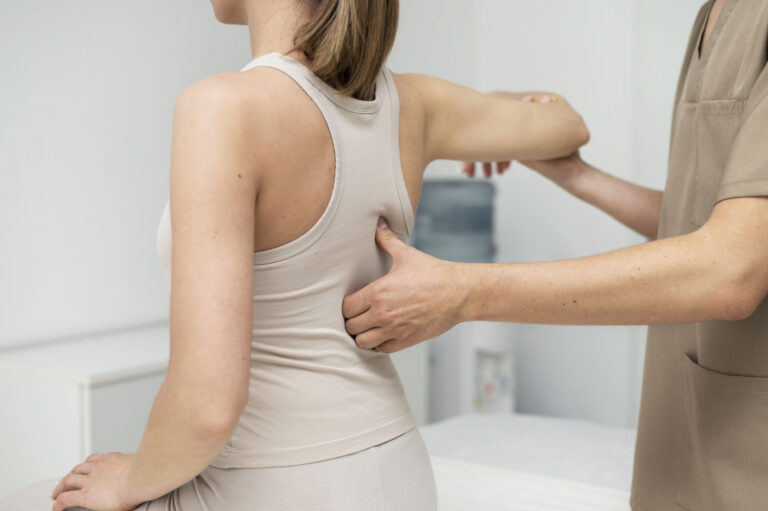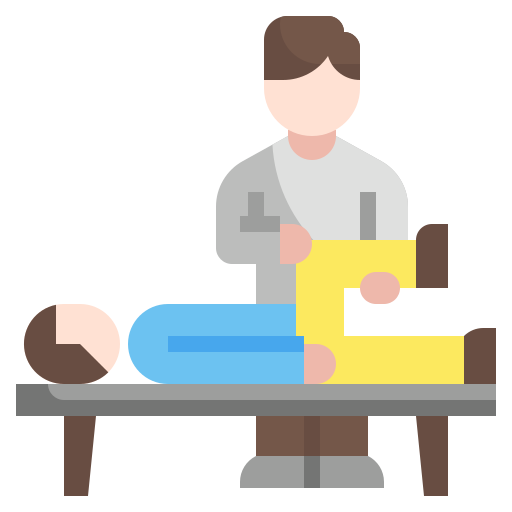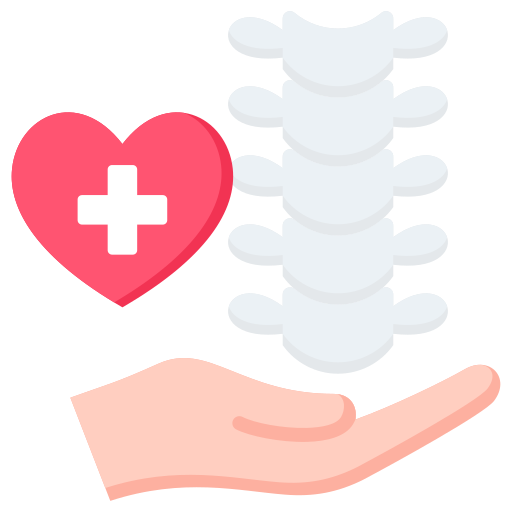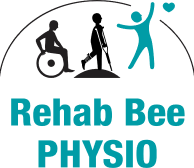Scoliosis Management
Scoliosis Management
What is Scoliosis?
Scoliosis is a condition where the spine curves sideways, forming an “S” or “C” shape rather than staying straight when viewed from the back. These spinal curves can happen in different parts of the spine—upper (thoracic), lower (lumbar), or at the junction between them (thoracolumbar). The severity of scoliosis varies from mild and barely noticeable, to more significant curves that affect posture, movement, and even breathing in some cases.
Scoliosis can affect anyone—from infants to older adults—but it most commonly develops during the growth spurt before or during adolescence. For many people, scoliosis starts subtly. You might notice uneven shoulders, a shift in the waist, or clothes not fitting properly on one side. The good news is that with early detection and proper care, scoliosis can be managed effectively—often without surgery. With the right treatment plan, individuals with scoliosis can lead active, healthy lives.

What is Scoliosis?
Scoliosis is a condition where the spine curves sideways, forming an “S” or “C” shape rather than staying straight when viewed from the back. These spinal curves can happen in different parts of the spine—upper (thoracic), lower (lumbar), or at the junction between them (thoracolumbar). The severity of scoliosis varies from mild and barely noticeable, to more significant curves that affect posture, movement, and even breathing in some cases.
Scoliosis can affect anyone—from infants to older adults—but it most commonly develops during the growth spurt before or during adolescence. For many people, scoliosis starts subtly. You might notice uneven shoulders, a shift in the waist, or clothes not fitting properly on one side. The good news is that with early detection and proper care, scoliosis can be managed effectively—often without surgery. With the right treatment plan, individuals with scoliosis can lead active, healthy lives.

Common Causes of Scoliosis
Scoliosis has multiple possible causes, and knowing the cause can help guide the best treatment. Here are the main causes linked to the types of scoliosis:
Common Causes of Scoliosis
Scoliosis has multiple possible causes, and knowing the cause can help guide the best treatment. Here are the main causes linked to the types of scoliosis:
Idiopathic
By far the most common cause of scoliosis, especially in kids and teens, is idiopathic, meaning no specific cause can be identified. Experts estimate that about 8 in 10 scoliosis cases have no known single cause. It’s possible genetics and growth factors play a role, but there’s no clear trigger. The good news is that idiopathic scoliosis is usually mild and can be monitored or treated with non-surgical methods during adolescence. When it comes to idiopathic scoliosis, certain risk factors increase the likelihood of developing this condition. Genetics, growth spurts during adolescence, and a family history of scoliosis are considered key risk factors.
Congenital
This type of scoliosis is caused by a bone abnormality in the spine that develops before birth. In congenital scoliosis, one or more vertebrae (spinal bones) didn’t form normally while the baby was in the womb. This can lead to a curved spine that is noticeable in infancy or early childhood. The cause of the bone malformation isn’t usually known, but it’s something that simply happens during fetal development. Babies and toddlers with congenital scoliosis are often followed closely by doctors as they grow, to ensure the curve doesn’t progress rapidly.
Idiopathic
By far the most common cause of scoliosis, especially in kids and teens, is idiopathic, meaning no specific cause can be identified. Experts estimate that about 8 in 10 scoliosis cases have no known single cause. It’s possible genetics and growth factors play a role, but there’s no clear trigger. The good news is that idiopathic scoliosis is usually mild and can be monitored or treated with non-surgical methods during adolescence. When it comes to idiopathic scoliosis, certain risk factors increase the likelihood of developing this condition. Genetics, growth spurts during adolescence, and a family history of scoliosis are considered key risk factors.
Congenital
This type of scoliosis is caused by a bone abnormality in the spine that develops before birth. In congenital scoliosis, one or more vertebrae (spinal bones) didn’t form normally while the baby was in the womb. This can lead to a curved spine that is noticeable in infancy or early childhood. The cause of the bone malformation isn’t usually known, but it’s something that simply happens during fetal development. Babies and toddlers with congenital scoliosis are often followed closely by doctors as they grow, to ensure the curve doesn’t progress rapidly.
Neuromuscular
This cause of scoliosis comes from other medical conditions that affect the muscles or nerves. For example, children with cerebral palsy, muscular dystrophy, spina bifida, or similar conditions may develop scoliosis because their muscles cannot fully support the spine’s alignment. The imbalance or weakness of the muscles around the spine allows the curve to form or worsen over time. Neuromuscular scoliosis varies in severity – some cases progress quickly – so these patients often benefit from early intervention (like bracing or therapy) to manage the curve.
Degenerative
In adults, particularly those middle-aged or older, scoliosis can develop due to degenerative changes in the spine. Over the years, the spinal discs can wear out and the joints can develop arthritis. This gradual wear-and-tear may cause the spine to start curving to the side – a condition often called degenerative scoliosis or adult-onset scoliosis. Factors like osteoporosis (weakening of the bones) can contribute as well. Typically, degenerative scoliosis happens slowly. Someone might not even realize their spine has curved until they feel some back pain or notice their posture changing in older age.
Neuromuscular
This cause of scoliosis comes from other medical conditions that affect the muscles or nerves. For example, children with cerebral palsy, muscular dystrophy, spina bifida, or similar conditions may develop scoliosis because their muscles cannot fully support the spine’s alignment. The imbalance or weakness of the muscles around the spine allows the curve to form or worsen over time. Neuromuscular scoliosis varies in severity – some cases progress quickly – so these patients often benefit from early intervention (like bracing or therapy) to manage the curve.
Degenerative
In adults, particularly those middle-aged or older, scoliosis can develop due to degenerative changes in the spine. Over the years, the spinal discs can wear out and the joints can develop arthritis. This gradual wear-and-tear may cause the spine to start curving to the side – a condition often called degenerative scoliosis or adult-onset scoliosis. Factors like osteoporosis (weakening of the bones) can contribute as well. Typically, degenerative scoliosis happens slowly. Someone might not even realize their spine has curved until they feel some back pain or notice their posture changing in older age.
Types of Scoliosis
Scoliosis can develop in different parts of the spine and take on various patterns. Understanding the type of scoliosis helps guide the best treatment approach, common type of scoliosis include adolescent scoliosis, infantile scoliosis, structural scoliosis, spinal fusion and more. Here are the most common types based on the location and curvature pattern:
Thoracic Scoliosis
This type affects the mid-back, where the rib cage connects to the spine (thoracic vertebrae). The curve typically bends to the right or left side and can cause the upper body to appear uneven.
Key signs:
- One shoulder sits higher than the other
- Shoulder blade appears more prominent
- Slight twist in the ribcage when bending forward
Lumbar Scoliosis
This form occurs in the lower back, involving the lumbar spine just above the pelvis. It may affect balance, posture, and lower back comfort.
Key signs:
- One hip appears higher or more forward
- Waistline looks uneven
- Lower back pain or stiffness, especially when standing long
Thoracolumbar Scoliosis
This curve starts in the mid-back and extends into the lower back. It's commonly seen in both adolescents and adults and can lead to posture and movement challenges.
Key signs:
- Combined shoulder and hip imbalance
- Visible curve through the middle of the back
- Generalised discomfort in both mid and lower back
Double Curve (S-Curve) Scoliosis
Also known as combined scoliosis, this involves two opposing curves—often one in the upper back and another in the lower spine. The body may try to "self-correct" to stay balanced, creating an S-shaped pattern.
Key signs:
- Shoulders and hips appear uneven
- Trunk may shift to one side
- More noticeable when viewed from behind
Cervicothoracic or Cervical Scoliosis
This type affects the junction between the neck and upper back, where the cervical and thoracic spine meet. The curve can tilt the head or neck to one side, causing visible imbalance. It’s often linked to congenital spinal abnormalities.
Key signs:
- Head tilt or neck rotation
- Uneven shoulder or collarbone height
- Restricted neck mobility
Types of Scoliosis
Scoliosis can develop in different parts of the spine and take on various patterns. Understanding the type of scoliosis helps guide the best treatment approach, common type of scoliosis include adolescent scoliosis, infantile scoliosis, structural scoliosis, spinal fusion and more. Here are the most common types based on the location and curvature pattern:
Thoracic Scoliosis
This type affects the mid-back, where the rib cage connects to the spine (thoracic vertebrae). The curve typically bends to the right or left side and can cause the upper body to appear uneven.
Key signs:
- One shoulder sits higher than the other
- Shoulder blade appears more prominent
- Slight twist in the ribcage when bending forward
Lumbar Scoliosis
This form occurs in the lower back, involving the lumbar spine just above the pelvis. It may affect balance, posture, and lower back comfort.
Key signs:
- One hip appears higher or more forward
- Waistline looks uneven
- Lower back pain or stiffness, especially when standing long
Thoracolumbar Scoliosis
This curve starts in the mid-back and extends into the lower back. It's commonly seen in both adolescents and adults and can lead to posture and movement challenges.
Key signs:
- Combined shoulder and hip imbalance
- Visible curve through the middle of the back
- Generalised discomfort in both mid and lower back
Double Curve (S-Curve) Scoliosis
Also known as combined scoliosis, this involves two opposing curves—often one in the upper back and another in the lower spine. The body may try to "self-correct" to stay balanced, creating an S-shaped pattern.
Key signs:
- Shoulders and hips appear uneven
- Trunk may shift to one side
- More noticeable when viewed from behind
Cervicothoracic or Cervical Scoliosis
This type affects the junction between the neck and upper back, where the cervical and thoracic spine meet. The curve can tilt the head or neck to one side, causing visible imbalance. It’s often linked to congenital spinal abnormalities.
Key signs:
- Head tilt or neck rotation
- Uneven shoulder or collarbone height
- Restricted neck mobility
Common Symptoms of Scoliosis
Scoliosis can sometimes be tricky to spot—especially if it’s mild scoliosis. Many people don’t feel any pain at first, and the early signs are often more about how the body looks than how it feels. But catching it early can really make a difference, especially for growing kids and teens.
Scoliosis screening is often performed in schools or during pediatric check-ups to detect abnormal spinal curvatures early. These screenings focus on assessing posture and alignment to identify any signs of scoliosis, allowing for timely intervention if abnormal spinal curvatures are found.
Uneven Shoulders
One shoulder may appear higher than the other, or one shoulder blade might stick out more. This happens when the spine curves to one side, pulling the upper body slightly out of alignment. It’s one of the earliest and most noticeable signs, especially in growing children.
Uneven Waist or Hips
The waistline might look slanted or one hip might seem more prominent. In girls, this can be noticed when skirts or pants seem to “tilt” to one side. This asymmetry is caused by the spine’s sideways curve shifting the pelvis and lower back muscles.
Visible Spine Curve or Body Leaning to One Side
When standing straight, a person with scoliosis might naturally lean to one side, even if they aren’t aware of it. This shift in posture is caused by the spine’s unnatural shape and can become more obvious as the curve progresses.
Ribs or Shoulder Blade Sticking Out
In cases of thoracic scoliosis, the ribs may be pushed out more on one side of the back due to spinal rotation. When a person is asked to bend forward, such as touching their toes, one side of the rib cage may appear raised—this is known as a “rib hump.”
Back Pain or Muscle Fatigue
While mild scoliosis in children is usually painless, adults—especially those with degenerative scoliosis—may experience lower back pain, tightness, or fatigue after standing or sitting for long periods. In some cases, lumbar scoliosis can cause discomfort on one side of the lower back as the muscles work harder to compensate for imbalance.
Limited Flexibility or Stiffness
As the spine curves, it may become harder to twist, bend, or maintain good posture. This can lead to stiffness or a feeling of “tightness” in the back or sides.
Symptoms by Age Group
Infants
Congenital Scoliosis
- Visible curve in the spine at birth
- Asymmetry in ribs or back
- Delays in crawling or sitting
- Tilting of the head or uneven chest shape
Children & Teenagers
Idiopathic Scoliosis
- No pain in early stages
- Uneven shoulders, hips, or waist
- Clothing fitting unevenly
- Curve detected during routine check-ups or school screening
Adults
Degenerative or Untreated Scoliosis
- Persistent lower back pain
- Postural imbalance or leaning
- Stiffness after long periods of standing
- Uneven height of hips or shoulders
- Fatigue in back muscles due to uneven load
Common Symptoms of Scoliosis
Scoliosis can sometimes be tricky to spot—especially if it’s mild scoliosis. Many people don’t feel any pain at first, and the early signs are often more about how the body looks than how it feels. But catching it early can really make a difference, especially for growing kids and teens.
Scoliosis screening is often performed in schools or during pediatric check-ups to detect abnormal spinal curvatures early. These screenings focus on assessing posture and alignment to identify any signs of scoliosis, allowing for timely intervention if abnormal spinal curvatures are found.
Uneven Shoulders
One shoulder may appear higher than the other, or one shoulder blade might stick out more. This happens when the spine curves to one side, pulling the upper body slightly out of alignment. It’s one of the earliest and most noticeable signs, especially in growing children.
Uneven Waist or Hips
The waistline might look slanted or one hip might seem more prominent. In girls, this can be noticed when skirts or pants seem to “tilt” to one side. This asymmetry is caused by the spine’s sideways curve shifting the pelvis and lower back muscles.
Visible Spine Curve or Body Leaning to One Side
When standing straight, a person with scoliosis might naturally lean to one side, even if they aren’t aware of it. This shift in posture is caused by the spine’s unnatural shape and can become more obvious as the curve progresses.
Ribs or Shoulder Blade Sticking Out
In cases of thoracic scoliosis, the ribs may be pushed out more on one side of the back due to spinal rotation. When a person is asked to bend forward, such as touching their toes, one side of the rib cage may appear raised—this is known as a “rib hump.”
Back Pain or Muscle Fatigue
While mild scoliosis in children is usually painless, adults—especially those with degenerative scoliosis—may experience lower back pain, tightness, or fatigue after standing or sitting for long periods. In some cases, lumbar scoliosis can cause discomfort on one side of the lower back as the muscles work harder to compensate for imbalance.
Limited Flexibility or Stiffness
As the spine curves, it may become harder to twist, bend, or maintain good posture. This can lead to stiffness or a feeling of “tightness” in the back or sides.
Symptoms by Age Group
Infants
Congenital Scoliosis
- Visible curve in the spine at birth
- Asymmetry in ribs or back
- Delays in crawling or sitting
- Tilting of the head or uneven chest shape
Children & Teenagers
Idiopathic Scoliosis
- No pain in early stages
- Uneven shoulders, hips, or waist
- Clothing fitting unevenly
- Curve detected during routine check-ups or school screening
Adults
Degenerative or Untreated Scoliosis
- Persistent lower back pain
- Stiffness after long periods of standing
- Uneven height of hips or shoulders
- Fatigue in back muscles due to uneven load
How We Treat Scoliosis At Rehab Bee Physio
At Rehab Bee Physio, we provide comprehensive scoliosis treatment using evidence-based approaches. Our team specialises in managing scoliosis through non-surgical interventions tailored to each patient’s unique needs.
We begin with a thorough assessment to determine the curve type, degree, and how it affects your daily activities. This evaluation helps us create a personalized treatment plan that addresses your specific condition. Diagnostic imaging such as X-rays or magnetic resonance imaging may be used to assess the spine in detail.
Scoliosis Physiotherapy
Physiotherapy is the foundation of non-surgical scoliosis management. At Rehab Bee, we use tailored movement programs that are designed to:
- Strengthen weakened core and spinal muscles
- Improve posture and balance
- Enhance spine stability during daily movements
- Reduce muscular imbalances caused by the spinal curve
Each program is customised based on your age and curve type—whether it’s mild scoliosis, thoracic scoliosis, or lumbar scoliosis. Physiotherapy helps reduce the risk of curve progression while improving comfort and confidence.
Manual Therapy
Our skilled physiotherapists also use manual therapy techniques to relieve stiffness and discomfort associated with scoliosis. These techniques include:
- Soft tissue release to reduce muscle tension and knots
- Spinal mobilisation to improve range of motion
- Myofascial release to improve tissue flexibility
Manual therapy is especially effective for adults experiencing degenerative scoliosis, as it helps manage chronic pain and restores ease of movement.
Schroth Method
The Schroth Method is a scoliosis-specific exercise approach that focuses on postural correction, 3D breathing, and spinal elongation. At Rehab Bee Physio, we guide patients through exercises tailored to their unique curve pattern. Key benefits include:
- Teaching the body to “self-correct” posture during daily activities
- Improving lung function through targeted breathing techniques
- Reducing spinal rotation and enhancing symmetry
- Increasing body awareness and long-term posture control
The Schroth Method is safe for all ages and particularly beneficial for adolescents with idiopathic scoliosis.
Scoliosis Bracing Support
For younger patients whose spines are still developing, we may recommend a scoliosis brace as part of their treatment plan—especially for curves that are progressing.
At Rehab Bee Physio, we don’t issue braces ourselves, but we work closely with orthotic specialists and provide:
- Education on proper brace usage
- Postural support through physiotherapy
- Strengthening exercises to prevent brace-related muscle weakening
It’s important to note that while bracing can help stop curve progression, it does not correct scoliosis. Once the brace is removed, there is still a risk of curve recurrence if proper muscle support is not maintained. That’s why physiotherapy and exercise remain essential during and after brace use.
How We Treat Scoliosis At Rehab Bee Physio
At Rehab Bee Physio, we provide comprehensive scoliosis treatment using evidence-based approaches. Our team specialises in managing scoliosis through non-surgical interventions tailored to each patient’s unique needs.
We begin with a thorough assessment to determine the curve type, degree, and how it affects your daily activities. This evaluation helps us create a personalized treatment plan that addresses your specific condition. Diagnostic imaging such as X-rays or magnetic resonance imaging may be used to assess the spine in detail.
Scoliosis Physiotherapy
Physiotherapy is the foundation of non-surgical scoliosis management. At Rehab Bee, we use tailored movement programs that are designed to:
- Strengthen weakened core and spinal muscles
- Improve posture and balance
- Enhance spine stability during daily movements
- Reduce muscular imbalances caused by the spinal curve
Each program is customised based on your age and curve type—whether it’s mild scoliosis, thoracic scoliosis, or lumbar scoliosis. Physiotherapy helps reduce the risk of curve progression while improving comfort and confidence.
Manual Therapy
Our skilled physiotherapists also use manual therapy techniques to relieve stiffness and discomfort associated with scoliosis. These techniques include:
- Soft tissue release to reduce muscle tension and knots
- Spinal mobilisation to improve range of motion
- Myofascial release to improve tissue flexibility
Manual therapy is especially effective for adults experiencing degenerative scoliosis, as it helps manage chronic pain and restores ease of movement.
Schroth Method
The Schroth Method is a scoliosis-specific exercise approach that focuses on postural correction, 3D breathing, and spinal elongation. At Rehab Bee Physio, we guide patients through exercises tailored to their unique curve pattern. Key benefits include:
- Teaching the body to “self-correct” posture during daily activities
- Improving lung function through targeted breathing techniques
- Reducing spinal rotation and enhancing symmetry
- Increasing body awareness and long-term posture control
The Schroth Method is safe for all ages and particularly beneficial for adolescents with idiopathic scoliosis.
Scoliosis Bracing Support
For younger patients whose spines are still developing, we may recommend a scoliosis brace as part of their treatment plan—especially for curves that are progressing.
At Rehab Bee Physio, we don’t issue braces ourselves, but we work closely with orthotic specialists and provide:
- Education on proper brace usage
- Postural support through physiotherapy
- Strengthening exercises to prevent brace-related muscle weakening
It’s important to note that while bracing can help stop curve progression, it does not correct scoliosis. Once the brace is removed, there is still a risk of curve recurrence if proper muscle support is not maintained. That’s why physiotherapy and exercise remain essential during and after brace use.
Why Rehab Bee Physio?
Why Rehab Bee Physio?

Highly Specialised Team by Areas

Covered by Insurance & Corporate Panels

Trusted by Media & University

Treatment That Fits You

Highly Certified Team

Trusted with 5 Star Google Reviews

Highly Specialised Team by Areas

Covered by Insurance & Corporate Panels

Highly Certified Team

Treatment That Fits You

Trusted with 5 Star Google Reviews

